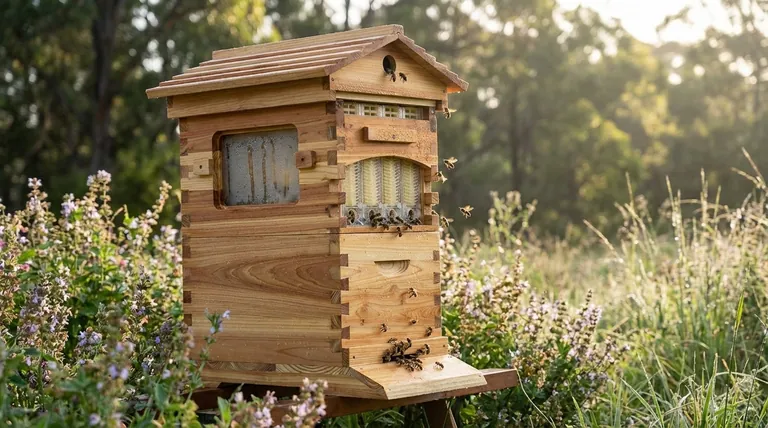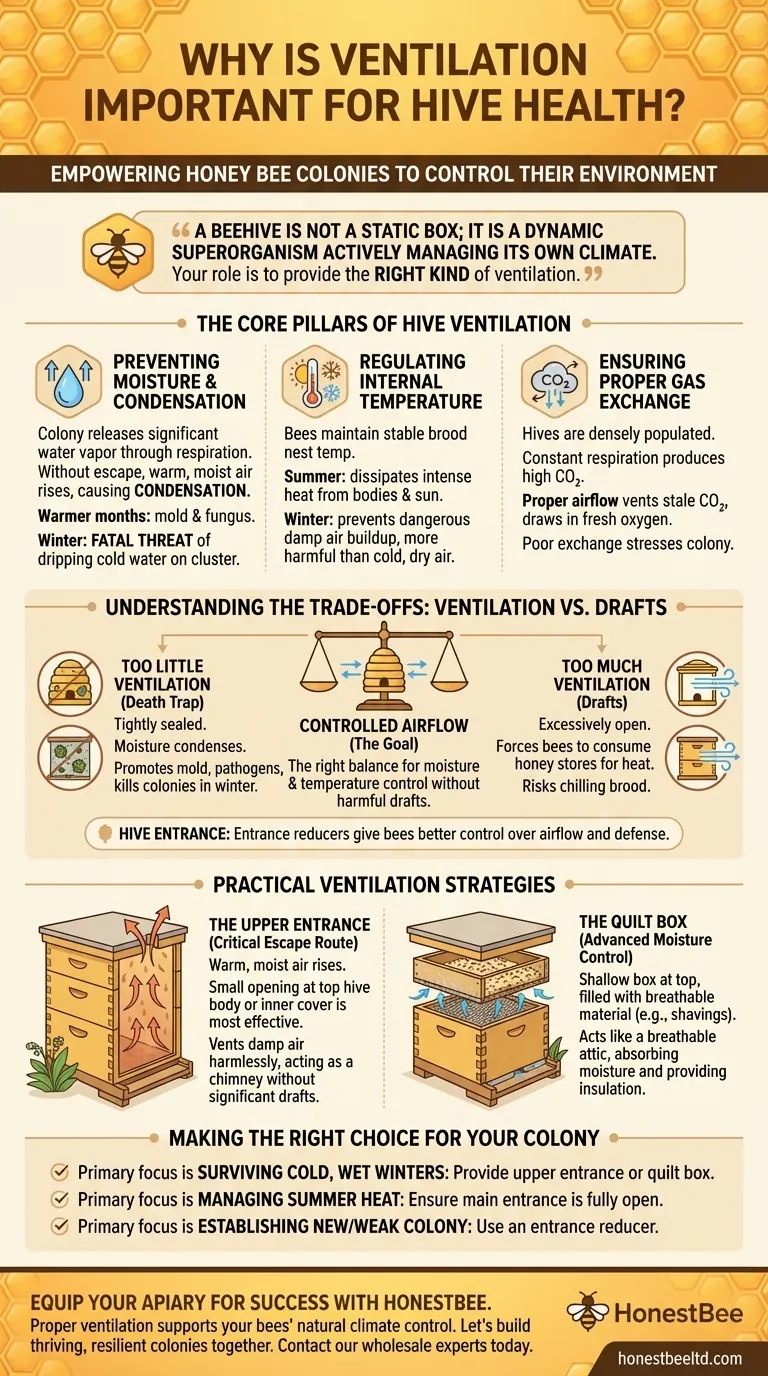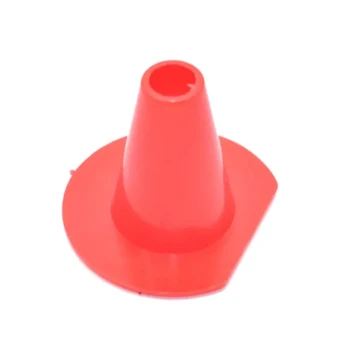Proper hive ventilation is essential because it empowers a honey bee colony to control its internal environment. It is the primary mechanism for preventing deadly moisture buildup, dissipating excess heat during warm months, and flushing out waste gases like carbon dioxide. A well-ventilated hive is a drier, healthier, and more stable home for your bees.
A beehive is not a static box; it is a dynamic superorganism actively managing its own climate. Your role is not just to provide airflow, but to provide the right kind of ventilation that helps the bees control moisture and temperature without creating a harmful draft.

The Core Pillars of Hive Ventilation
Understanding why ventilation matters comes down to three key environmental factors that bees must constantly manage. Your ventilation strategy should support their efforts in each area.
Preventing Moisture and Condensation
A colony of bees releases a significant amount of water vapor through respiration—just like we do when we exhale. Without an escape route, this warm, moist air rises and hits the cold inner surfaces of the hive.
This process creates condensation. In warmer months, this leads to mold and fungus growth. In winter, it is a fatal threat, as cold water can drip down onto the cluster, chilling and killing the bees.
Regulating Internal Temperature
Bees work tirelessly to maintain a stable temperature, especially in the brood nest where larvae are developing.
In the summer, ventilation helps dissipate the intense heat generated by thousands of bee bodies and the sun beating down on the hive. In the winter, it prevents the buildup of damp air, which is far more dangerous to the cluster than cold, dry air.
Ensuring Proper Gas Exchange
A hive is a densely populated space. The constant respiration of the colony produces high levels of carbon dioxide (CO₂).
Proper airflow is necessary to vent this stale, CO₂-rich air and draw in fresh, oxygenated air. Poor gas exchange stresses the colony and can impede healthy development.
Understanding the Trade-offs: Ventilation vs. Drafts
The goal is controlled airflow, not a wind tunnel. Many beekeepers are hesitant to create openings in the hive, fearing it will make the bees cold. This is where understanding the balance is critical.
The Danger of "Too Little" Ventilation
A tightly sealed hive is a death trap, especially in winter. It guarantees that moisture will condense, creating the damp, cold conditions that kill colonies and promote the growth of mold and pathogens.
The Danger of "Too Much" Ventilation
Conversely, an excessively open hive can create a draft. This forces the bees to consume more of their vital honey stores to generate the heat needed to stay warm and protect the brood.
The Role of the Hive Entrance
The entrance is a key ventilation point. Using an entrance reducer on a new or weak colony does not stop ventilation; it gives the bees better control over the airflow. A smaller entrance is also easier for them to defend from pests and robbing bees from other hives.
Practical Ventilation Strategies
Effective ventilation is about providing a path for air to move through the hive naturally. The most important principle is allowing warm, moist air to escape at the top.
The Upper Entrance: A Critical Escape Route
Physics dictates that warm, moist air rises. An upper entrance—a small, dime-sized hole in the top hive body or a notch in the inner cover—is the single most effective way to manage moisture.
This small opening allows that damp air to vent harmlessly outside before it can condense and drip back down on the bees. It does not create a significant draft but works as a chimney.
The Quilt Box: Advanced Moisture Control
A quilt box is a shallow box placed at the very top of the hive, below the outer cover. It has a screened bottom and is filled with a breathable material like wood shavings.
This setup acts like a breathable attic. It absorbs moisture from the hive, wicking it up and away from the bees, while the shavings provide an extra layer of insulation.
Making the Right Choice for Your Colony
Your ventilation strategy should adapt to the season and the strength of your colony.
- If your primary focus is surviving cold, wet winters: Provide an upper entrance or a quilt box to allow moisture to escape.
- If your primary focus is managing summer heat: Ensure the main entrance is fully open and free of obstructions to maximize airflow.
- If your primary focus is establishing a new or weak colony: Use an entrance reducer to help them control their climate and defend their home more easily.
By managing ventilation, you shift from simply keeping bees to actively partnering with them to build a thriving and resilient colony.
Summary Table:
| Ventilation Goal | Key Benefit | Key Risk Without It |
|---|---|---|
| Moisture Control | Prevents mold, fungus, and fatal winter condensation. | Damp, cold conditions that kill the colony. |
| Temperature Regulation | Dissipates excess summer heat; maintains stable brood nest temperature. | Overheating in summer; inability to maintain cluster warmth in winter. |
| Gas Exchange | Vents CO₂ and draws in fresh oxygen. | Stressed colony and impeded healthy development. |
Equip your apiary for success with HONESTBEE. Proper ventilation is just one part of a healthy hive. As a trusted supplier for commercial apiaries and beekeeping equipment distributors, we provide the durable, well-designed supplies—from inner covers with notches for upper entrances to robust hive bodies—that support your bees' natural climate control. Let's build thriving, resilient colonies together. Contact our wholesale experts today to discuss your needs.
Visual Guide

Related Products
- Automatic Honey Flow Beehive 4 Frame Mini Hive for Beekeeping
- Wholesales Dadant Size Wooden Bee Hives for Beekeeping
- Professional Insulated Winter Hive Wrap for Beekeeping
- Professional Insulated Plastic Bee Hives
- Long Langstroth Style Horizontal Top Bar Hive for Wholesale
People Also Ask
- How to extract honey in Flow Hives? Experience the Simplicity of Honey on Tap
- How does the Flow Hive improve bee health? By Minimizing Stress During Honey Harvest
- What are the benefits of a Flow Hive? Revolutionize Your Harvest with Ease and Care
- How long does it take to get honey from a Flow Hive? Fast Harvesting Explained
- What is the selling point of the Flow Hive? A Revolutionary, Stress-Free Honey Harvest



















